December 29, 2023
Air Date: December 29, 2023
FULL SHOW
SEGMENTS
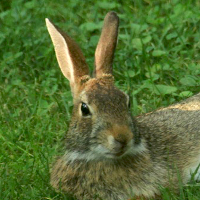
Care for the Common Critter
View the page for this story
As a wildlife rehabilitator, Julie Zickefoose has had some remarkable encounters with animals. She joins Bobby Bascomb to share some of her own stories and animal insights as well as tales of uncommon encounters others have had while helping common woodchucks and rabbits in need. (12:21)
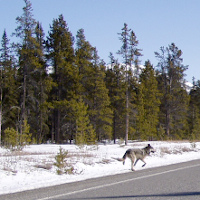
‘It Could Be the Last One’: Stories of People Helping Rare Critters
View the page for this story
As an endangered species advocate, Tierra Curry gets calls and emails from strangers across the country who think they might have found the very last plant or animal of a particular rare species. She shares some of the most humorous and heartwarming stories with Jenni Doering, as well as a story about her own breathtaking encounter with a wolf in an Alaskan snowstorm. (08:34)
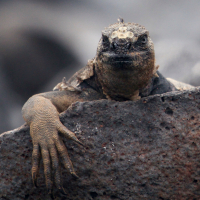
Wildly Magical: Animal Encounters in the Galapagos
View the page for this story
Writer Jennifer Junghans had always dreamed of going to the Galapagos to swim with the marine iguanas. In 2017 she finally had her chance, and although the iguanas stayed high and dry, the experience brought her up close with blue-footed boobies and blacktip sharks, and face-to-face with a curious pufferfish. Jennifer shares her story of visiting “the remote wilderness of her dreams” with Aynsley O’Neill, who spent a memorable summer studying in the Galapagos. (10:11)
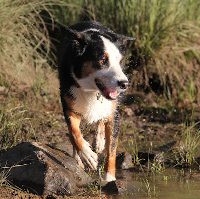
Native American Stories of Human and Animal Kinship
View the page for this story
Many Native American communities belong to a clan which identifies with an animal, like the bear, deer, or loon, and they are featured in their stories. Storyteller and musician Joe Bruchac of the Nulhegan Abenaki tribe joins Bobby Bascomb to share flute music and stories of how the dog came to be a loyal human companion, as well as lessons from a mother bear. (16:33)
Show Credits and Funders
Show Transcript
210101 Transcript
HOSTS: Bobby Bascomb, Jenni Doering, Aynsley O’Neill
GUESTS: Joe Bruchac, Tierra Curry, Jennifer Junghans, Julie Zickefoose
[THEME]
BASCOMB: From PRX – this is Living On Earth.
[THEME]
BASCOMB: I’m Bobby Bascomb and to celebrate the season we’re taking a break from the news with an hour of stories starring animals, including a mother rabbit determined to care for her young.
ZICKEFOOSE: I mean, she was not gonna let anything stop her, and I think people think of rabbits as these timid little shivering animals but they're anything but. These things know what they're doing and this mother wanted to get to her babies, and by God she did. She just needed a little help.
DOERING: And I’m Jenni Doering, also, a scientist shares her close encounter with wildlife during an Alaskan snow storm.
CURRY: I was driving to this flight center, with the two bald eagles in my back seat, which was cool enough. But I kept having to get out of the car and chink the ice off my windshield wipers and I look up, and there's a wolf at the edge of the woods, just looking at me.
O’NEILL: And I’m Aynsley O’Neill with bunnies, and eagles, and wolves oh my! Animal story telling this week on Living on Earth – Stick Around!
[NEWSBREAK MUSIC: Boards Of Canada “Zoetrope” from “In A Beautiful Place Out In The Country” (Warp Records 2000)]
[THEME]
Care for the Common Critter
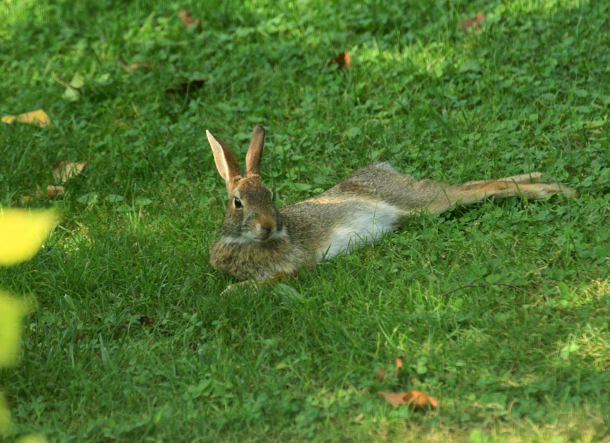
A wild rabbit Julie Zickefoose loved which she called “Red,” relaxing in her yard. (Photo: Julie Zickefoose)
BASCOMB: From PRX and the Jennifer and Ted Stanley studios at the University of Massachusetts Boston, this is Living on Earth. I’m Bobby Bascomb.
DOERING: I’m Jenni Doering.
O’NEILL: And I’m Aynsley O’Neill.
As you guys know, for these couple of weeks around the holidays and the winter solstice we like to take a little break from the news to share some storytelling on the show.
DOERING: Yeah, and for today’s show, we asked some of our favorite story tellers and guests to share some of their animal stories with us. Bobby, I think you talked with Julie Zickefoose I mean, thanks to her I’m noticing blue jays everywhere these days.
BASCOMB: Yeah me too! She told us about a baby blue jay that she raised and released into the wild. She wrote and illustrated a beautiful book about Jemima, that baby blue jay. And when I talked with her I learned she’s had some really amazing experiences with all kind of animals in her work as a wildlife rehabilitator. So, take a listen. She’s really got a soft spot for animals that a lot of us might think of as pests.
ZICKEFOOSE: I have a special affection for woodchucks. Woodchucks are just extraordinary animals, and I think that only those of us who've come to know them personally might realize this. I think a lot of people think of them as just big garden eaters and diggers and things like that. But I had a friend who's now passed on. His name was Tom Ross, and he lived in the Amish country of Ohio. And he shared this story with me.
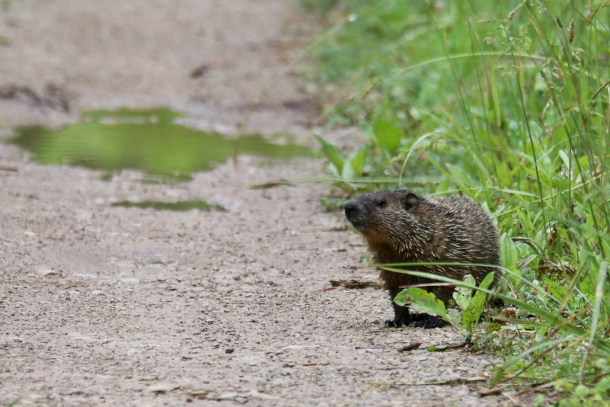
A wild woodchuck encountered on one of Julie’s hikes. (Photo: Julie Zickefoose)
[MUSIC: Josh Kimbrough, "Glowing Treetops" on Slither, Soar & Disappear, Tompkins Square Records 2020]
In the early 1970s, Tom had an office, he was an architect. And it was in a home that was completely surrounded by commercial developments, strip malls and stores and that kind of thing. And a woodchuck somehow hung on and lived in the hedge in the front of the building, and had a burrow down there, and it grazed out on the lawn. And one day Tom received notice that the building was going to be demolished. And he knew that the woodchuck would be killed when the lot was bulldozed. So he was afraid what would become of it. So he moved his office, all the architects got their stuff out, and they were loading up their cars with all their stuff. And Tom had brought a wooden cage from home, and he was intending to live trap this woodchuck and then move it to safety. And he wrote me a letter about this, he said:
"When we had finished loading the car, I walked around the front to try to spot the woodchuck's hole. Parting the yews planted around the foundation, I was shocked to see the woodchuck sitting there, looking up at me.”
[MUSIC: Josh Kimbrough, "Glowing Treetops" on Slither, Soar & Disappear, Tompkins Square Records 2020]
"He was not timid and didn't run. It was almost as if he'd been expecting me. As I stood transfixed, he came to the front of the bushes and stood up with his front paws on my leg like a dog. I reached down and scratched the top of his head, then slowly backed up and started to the back of the house to get the cage. At this, he followed me around the house, walked of his own volition straight into the cage, and I closed the gate. We then placed the cage in the car, drove out to the country where I keep my bees and released him. The woodchuck set up housekeeping there, and I saw him frequently the rest of the summer."
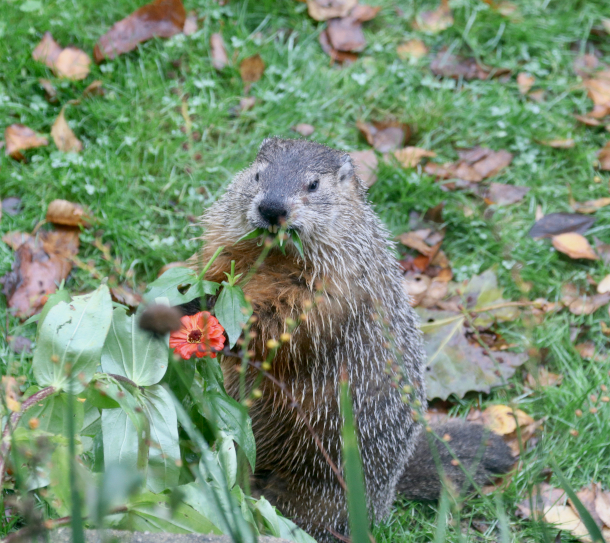
A woodchuck who hung around Julie’s yard one summer and fall, destroying a zinnia. (Photo: Julie Zickefoose)
BASCOMB: Wow, that's amazing. So the woodchuck knew? I mean, how did the woodchuck know what was going to happen, and that this was somebody who could help him?
ZICKEFOOSE: Yeah, exactly. I think there is a mechanism by which the woodchuck knew. I think that he was seeing what was going on. He saw the people moving out. But he also saw the pictures in Tom's mind of the demolishing of the house. He sensed the concern. He received the message that something bad was about to happen to his home. And I think he did what made sense to him, which was to let the person help him.
BASCOMB: And, so I understand that you have another story for us about people helping animals.
ZICKEFOOSE: Well, I do. And again, I'm going to talk about a garden pest, a cottontail rabbit, which is not something you want in your garden.
BASCOMB: No.
ZICKEFOOSE: But this one spring, I was rototilling my garden and I noticed a little tiny tuft of rabbit fur, next to a bale of straw. And I knew what that meant. I put my finger down through the straw and into the earth. And there was a little fur-lined bowl there and there were some warm, slippery, sleek baby rabbits in there.
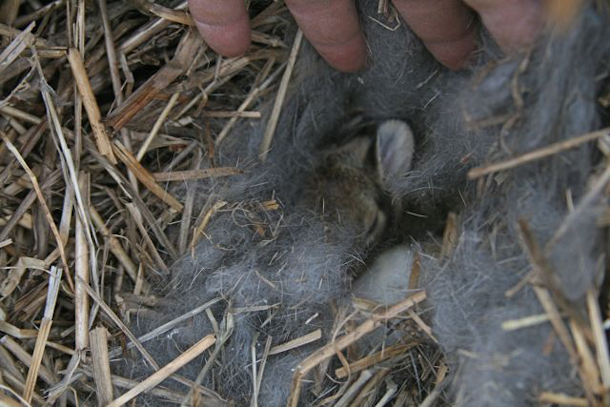
What it's like to find a rabbit nest. That sudden intake of breath at the perfection hiding under the fur and straw. (Photo: Julie Zickefoose)
[MUSIC: Josh Kimbrough, "Eyes on the Moon" on Slither, Soar & Disappear, Tompkins Square Records 2020]
The mother rabbit pulls fur out of her belly and makes a beautiful blanket that she pulls over the babies when she has to leave them. And so there they were. And I thought, Oh my gosh, I've got to stop all operations in here right now. So I put the blanket back over them. And that night there was supposed to be a violent thunderstorm. So I put a wheelbarrow upside down, elevated by a couple of bricks so that the rabbit could crawl under it, but, you know, nothing else could get to them. So sure enough, when I went to check them in the morning, they were warm and dry under there and obviously the rabbit had crawled in in the night to nurse them. That's what rabbits do. They nurse their babies all night and then they leave them all day.
BASCOMB: Hmm.
ZICKEFOOSE: So I went ahead and planted the peas and the lettuce, and I left the nest with the wheelbarrow over it alone and I checked on the little rabbit kits every couple of days to make sure they were still all right.
[MUSIC: Josh Kimbrough, "Eyes on the Moon" on Slither, Soar & Disappear, Tompkins Square Records 2020]
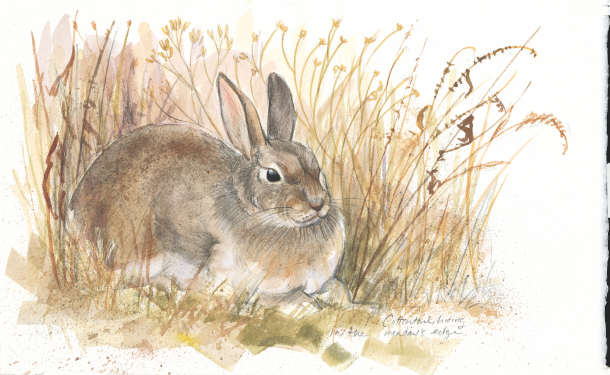
A watercolor by Julie Zickefoose of a resting cottontail, done from life. (Image: Julie Zickefoose)
And one day I forgot and I closed the garden door, and she had been just coming in and out of the open door of the fencing, and she had chewed a five-inch hole in the mesh to get through to her babies, so nothing was gonna stop her. Anyway, the babies made it fine, they left, everything was great. And I was very, very glad that I'd discovered that nest and didn't rototill it up. So then I got to thinking about back to the mid 1970s, when I was going to a lot of old-time music festivals, and there was this one called Brandywine in Pennsylvania, and it was a fabulous time. And what they would do was every summer they would mow this hay field. And that would be pressed into service as a parking lot. And then people also would cast their tents in the lot. So I had just gotten there. And I was walking toward the sound of the fiddles and the banjos, and I was all excited, I had my big gypsy skirt on and my felt hat. And I saw a little tuft of rabbit fur in the hay.
[MUSIC: Josh Kimbrough, "Glowing Treetops" on Slither, Soar & Disappear, Tompkins Square Records 2020]
And I thought, Oh, boy. So I felt down through the hay that had been cut. And sure enough, there were these pink naked baby rabbits there, in a nest. And I looked to the left and there was a tent and to the right, there was another tent, and then behind me were cars. It was overrun by people. So I thought, Ah! What do I do, this is a four day festival. I can't take the rabbits, I've got to make it so that the mother can get to them but nobody will step on them or drive over them. So I found some wooden stakes and some twine and some paper and I cordoned off the nest and I made a sign that said, "Rabbit Nest, Please Keep Away." So there was just this little triangle, this little oasis for these babies. And every morning I came back to check on the baby rabbits.
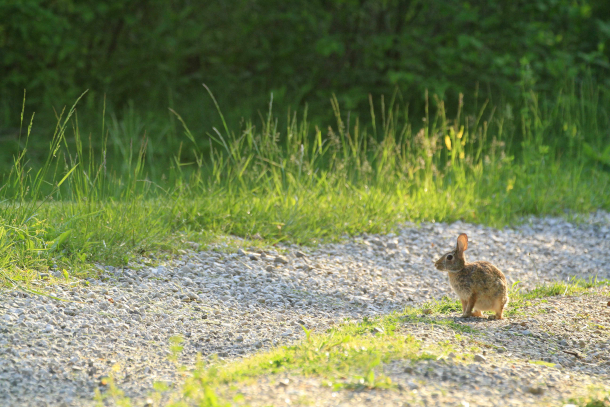
“Spring” the rabbit in Julie’s driveway. (Photo: Julie Zickefoose)
[MUSIC: Josh Kimbrough, "Glowing Treetops" on Slither, Soar & Disappear, Tompkins Square Records 2020]
And each time they were warm and dry, and their bellies were round and full. And I realized that this mother rabbit had made her way through enemy lines at night, past the tents and the cars and the people playing in the parking lot, to nurse her young, and she had made it happen. So at the end of the four-day festival, everybody packed up their tents and left, and the young rabbits were still alive and warm and waiting for their mother.
BASCOMB: Oh, that's a beautiful story. There's nothing like the determination of a mother, you know?
ZICKEFOOSE: Exactly. I mean, she was not going to let anything stop her. And I think people think of rabbits as these timid little shivering animals, but they're anything but. This mother wanted to get to her babies and by God, she did.
BASCOMB: Mm hmm.
ZICKEFOOSE: She just needed a little help.
BASCOMB: Yeah. And I understand you have one more story for us, also about rabbits.

A rabbit Julie called “Notch”, whom Julie adored even though he ate all the lobelia. (Photo: Julie Zickefoose)
ZICKEFOOSE: I do. And again, it's a wonderful story, but it's not mine. This is a friend of mine, who like Tom Ross has also passed away. She was an incredible woman named Christine Carpenter. And she had wild rabbits come up to her and ask for help.
[MUSIC: Blue Dot Sessions, "Suzy Textile" on Cloud Harbor, Blue Dot Studios 2020]
It started with one rabbit. She and her husband saw a rabbit lying by a cherry tree in their yard, this was in Ohio. And they went over and looked at it, figuring it was dying, and it was certainly in bad shape. There's a parasite that rabbits get, and it's called a warble fly. It lays its egg under the skin of the rabbit. And then the larva grows up as a parasite and makes a big knot on the skin of the rabbit. A really badly afflicted rabbit kind of looks like a sack of marbles.
BASCOMB: Hmm.
ZICKEFOOSE: So this poor rabbit was covered with warble fly larvae and knots. They saw the warbles they had seen them on tame rabbits and knew what to do.
[MUSIC: Blue Dot Sessions, "Suzy Textile" on Cloud Harbor, Blue Dot Studios 2020]
So they put on gloves and they got a needle nose pliers and a scissors. And they removed all the warble larvae from this animal. It allowed them to do it. It didn't struggle. They brought it into the house. They gave it some water and some food, and they put it in the bathtub overnight and they were pretty sure it would be dead in the morning. But in the morning, it was ricocheting around the bathtub. And they opened the bathroom door and the door to the outside and the rabbit rocketed out into the yard and was clearly still fine. And, one might presume, grateful. So they thought, Well, that was cool.
[MUSIC: Blue Dot Sessions, "Suzy Textile" on Cloud Harbor, Blue Dot Studios 2020]
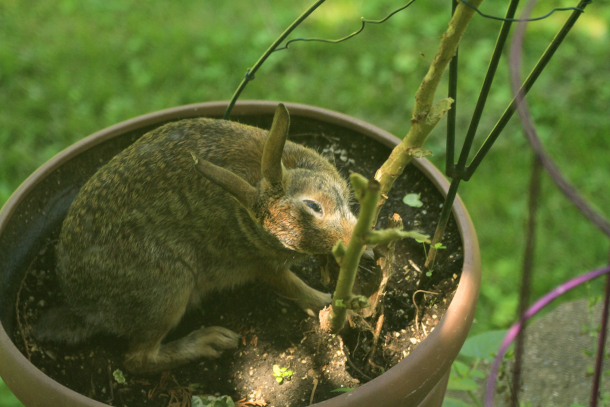
Notch, destroying a once-luxuriant geranium. He climbed up into Julie’s planters to do his dirty work. (Photo: Julie Zickefoose)
But then, what happened was, two more rabbits presented themselves to Christine. They came up to her, and they, too, had bad warbles. And, again, Christine and her husband gloved up and put on long sleeves and you know, held the rabbits which struggled a little, as a wild rabbit would, but they allow themselves to be picked up. And they allow the operation to be done. And they went out and prospered after that.
BASCOMB: You know, Julie, it reminds me of your story of the woodchuck. You know, the woodchuck somehow knew that this guy was gonna, gonna help him, and the rabbits just somehow knew that, you know, there was a friend here that could help them out. And it's really nice to think of.
ZICKEFOOSE: Yeah. Well, it's, you know, lots of people are probably familiar with the tale of Androcles and the Lion, where a wild lion allowed Androcles to remove a thorn from its paw. So clearly, this is an old archetype. This is something that people have been doing with animals for many, many, many centuries. And I think it's something that, that we need to look for in everyday life and, and look for ways to stop and help animals. It's a different way to look at the natural world, and a beautiful way, really.
[MUSIC: Josh Kimbrough, "Eyes on the Moon" on Slither, Soar & Disappear, Tompkins Square Records 2020]
BASCOMB: Julie Zickefoose is a part-time wildlife rehabilitator, artist and author of several books, including Saving Jemima: Life and Love with a Hard-luck Jay. Julie, thank you so much for sharing all of these wonderful stories with us.
ZICKEFOOSE: Well thank you, Bobby. It's such an honor to be on Living on Earth. Thank you so much.
Related links:
- Find Julie’s books, artwork and more here
- Julie’s LOE interview about her book “Saving Jemima: Life and Love with a Hard-Luck Jay”
- Read Julie's blogpost about these stories
[MUSIC: Josh Kimbrough, "Eyes on the Moon" on Slither, Soar & Disappear, Tompkins Square Records 2020]
‘It Could Be the Last One’: Stories of People Helping Rare Critters
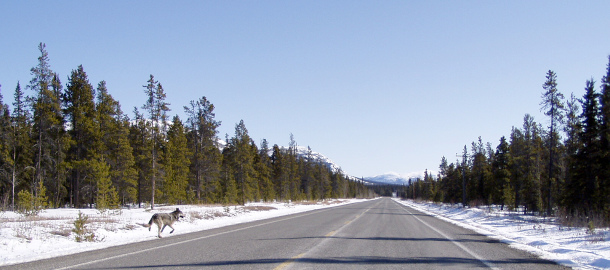
A wolf crosses the highway in Whitehorse, Yukon. (Photo: Joseph, Flickr, CC BY-SA 2.0)
BASCOMB: It’s Living on Earth, I’m Bobby Bascomb.
DOERING: I’m Jenni Doering.
O’NEILL: And I’m Aynsley O’Neill.
We continue our holiday special now with some more animal stories. Jenni, what do you have for us?
DOERING: Yeah, I talked with Tierra Curry, she is a senior scientist with the Center for Biological Diversity. Today she mostly has a desk job, working towards getting legal protection for endangered species, plants and animals but she started by telling me about a close encounter she had a while back working with animals in Alaska.
CURRY: I want to go back to about a decade ago when I lived in Alaska. I was volunteering at a wildlife rehabilitation center that focused on birds. And because Alaska is such a wild place, we would get bald eagles in regularly, so I got to work with them pretty much on a daily basis. And just getting to know so many different bald eagles, I came to understand that they even looked different, and they had different personalities. And it kind of changed the way that I think about wildlife. Because it just made me realize that we think of wild animals as, like, all the ones in a group being the same, but they're all different. They have their lives and their personalities, and you know, their schedules. And so at the clinic, some of the bald eagles were very shy and they would, like, never interact with us. And some of them were really mad to be there. And they just, like, wanted to attack us. And some of them were just very kind and cooperative. And one of the amazing experiences that I had at that clinic is after the birds were feeling better, they went out to a flight center to work up their strength and learn to fly again before they were released into the wild. And so, one winter morning, it was my job to take two bald eagles in really large dog kennels out to this flight center. And there happened to just be a huge blizzard that day. And in Anchorage, when there's a blizzard, your life doesn't shut down, you just keep going. And so you just go out on the road and try to make a lane and hope for the best. And so I was driving to this Flight Center with the two bald eagles in my backseat, which was cool enough, but I kept having to get out of the car and chink the ice off my windshield wipers. And because this was my first winter in Alaska, I didn't even really have an ice scraper. So, I'm embarrassed to say this, but I was using a credit card. I'm just like stuck there with my head down, it's pouring snow, I'm sure my hair's freezing and, and I look up and there's a wolf at the edge of the woods, just looking at me. And I stared back at it. And it was just this moment where I was hyper aware of being a human. I'm here, at this moment, on a Tuesday morning, outside Anchorage. And this wolf is here too. And we just stared at each other and shared this moment. And we're both dealing with the snow, it was having trouble walking, it kept postholing and, like, having to push against the snow with its chest. And we were both surprised by the encounter. And then we both just went on about our schedules after that moment, but it's a moment that I'll, I'll just never forget.
DOERING: Hmm. Was that the first time that you had seen a wolf?
One of the wolves spotted by Tierra on the side of the road in Denali. (Photo: Courtesy of Tierra Curry)
CURRY: You know, I'd seen wolves in Denali on a tour bus with lots of other people. We saw, like, 12 wolves in one day at the very end of fall when all the animals are active and trying to put on weight for the winter. And I'd seen them at a distance in Yellowstone but to just run into one in the course of the morning and have this moment with it, just me and the wolf, in this terrible weather. It was, it was amazing.
DOERING: So Tierra, I'm sure your job at the Center for Biological Diversity has brought you some pretty neat wildlife encounter stories. Would you like to share some of those with us?
CURRY: I would. One of the best parts about my job, the most interesting parts, for sure, I work on endangered species around the whole country, but at the policy level. So I'm usually just, like, behind my desk working on policy documents. But because of this, I work on all kinds of species across the country, from crayfish to butterflies to the Humboldt martens, just whatever is endangered and needs help if it's a plant or an animal. And people contact me regularly when they have an experience with one of these animals. Like, if someone has a monarch butterfly that they've watched grow from a caterpillar and it isn't doing what they think it should be doing, they contact me for advice. That ranges from "my monarch lacks self confidence" to, like, it's the wrong color, or should I help it out of its shell. Or one time somebody found me because their dog was down in the creek and came back with a blue crayfish attached to its lip. And they had heard on the news that there was this endangered blue crayfish and so they wanted to see if their crayfish that their dog brought home was endangered and what they should do about it. I sent the pictures to crayfish researchers in that state and it actually was a species that we had petitioned for protection for and this ended up being a new location for it. But in terms of the immediate, I told them just to put it back in the creek, but the researcher was really glad to have the information about a new population of it. Kind of the most touching of these stories, one time, there was a fairy shrimp in Florida called the Florida fairy shrimp and we petitioned for protection for it, and the Fish and Wildlife Service said that it was extinct.
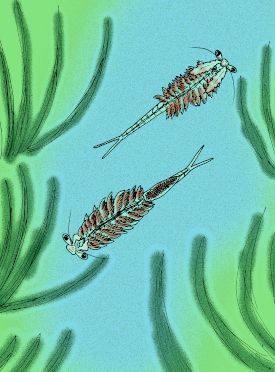
An artist’s rendering of the Florida fairy shrimp, which was declared extinct when the pool that contained the entire known population was destroyed for construction work. (Photo: Apokryltaros, Wikimedia Commons, CC BY-SA 4.0)
And so that was hard and we put out a press release about the Florida fairy shrimp being gone. And then, this woman a couple months later, the roads around her house flooded and she found a bunch of fairy shrimp on the road. And she thought that maybe these fairy shrimp were the Florida fairy shrimp and she didn't know what to do. So she contacted me and I told her to contact somebody local, you know, to see what they were. And she just went out of her way. She contacted the state Wildlife Commission, a local Marine Lab. Upon their advice, she went and bought a tank and like food to feed them. She just wanted so desperately to help these fairy shrimp. And she felt so much responsibility, because beyond compassion for the individual animals, she was afraid they were going to get run over, or that vector control was going to spray for mosquitoes and that it would kill them. She felt responsibility for the fate of the entire species. What if she had found this animal that was just declared extinct. And for days, it took over her life, she dropped, like, everything she was doing to try to take care of these fish shrimp to see if she could save the species. And I was just so touched, and I felt so helpless, but also so grateful to her, like, faced with this urgency and feeling the meaningfulness of the moment. And I think that, like, a lot of people, they hear about the extinction crisis, and they want to help and they want to be a good human being and do the right thing. And then they encounter this really rare animal that could be the last of its kind and they don't know what to do, and somehow they find me.
DOERING: So, Tierra, were those fairy shrimp that this woman spent three days of her life agonizing over, were they ultimately you know, this extinct species?
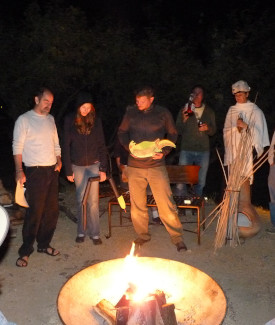
Tierra (second from the left) and her colleagues at the Center for Biological Diversity held a memorial service for the Florida fairy shrimp and a subspecies of rainbow snake in 2011. (Photo: Courtesy of Tierra Curry)
CURRY: No, they ended up being the common species of fairy shrimp in that area. But they could have been! So it's really important that when people do have these encounters, they report it to someone who could help save them because it's entirely possible that it's just something that researchers didn't find, and that you could find it. And most of the time, the answer is just like, leave the animal where it is, it'll be fine. But it's an honor for me to get to talk to people who are having these intense experiences. But sometimes, it's not so good. Sometimes people just kidnap stuff that they shouldn't kidnap.
DOERING: What did they do?
CURRY: Well, one time I got an email that was titled, my pika won't poop.
DOERING: [LAUGHS]
CURRY: Pikas are little, rabbit-like animals that live on talus slopes in the west, and they squeak.
[PIKA SQUEAK SFX]
CURRY: Like, if you've ever been hiking in the high mountain west and you hear a little squeak it's probably a pika.
[PIKA SQUEAK SFX]
CURRY: But anyway, I got this email one day called my pika won't poop and I just think oh, no. And I opened it, and someone had brought home a pika. It hadn't eaten or pooped for days and they didn't know what to do. And so of course, I told them, take the pika back.
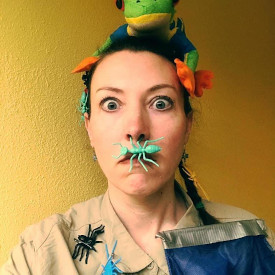
Tierra Curry, here dressed as a wildlife biologist for an amusing work-from-home video call, is a Senior Scientist with the Center for Biological Diversity. (Photo: Courtesy of Tierra Curry)
DOERING: Yeah, I really hope they did. I mean, it can't be good for the pika. So Tierra, if someone at home listening to this does find some critter that they think maybe is an endangered species, or you know, we thought it was extinct. What would you recommend that they do?
CURRY: In general, just take a picture, take a bunch of pictures of it, don't disturb it. If it is in danger of getting run over, or getting sprayed by vector control, like those were kind of extenuating circumstances for the fairy shrimp. Mostly just take the pictures so that you can contact the researcher or contact me and I can find the researcher to find out what it is. Most of the time unless an animal is hurt, even if it is hurt. Probably don't pick it up. Just contact somebody who has the skills to go pick it up.
DOERING: Well, thank you so much for sharing these wonderful stories, Tierra.
CURRY: Thanks, Jenni. Take care.
Related links:
- The Center for Biological Diversity’s Saving Life on Earth Campaign
- The Center for Biological Diversity
[MUSIC: Tommy Emmanuel, John Knowles, “How Deep is Your Love” on Heart Songs, CGP SOUNDS]
Wildly Magical: Animal Encounters in the Galapagos
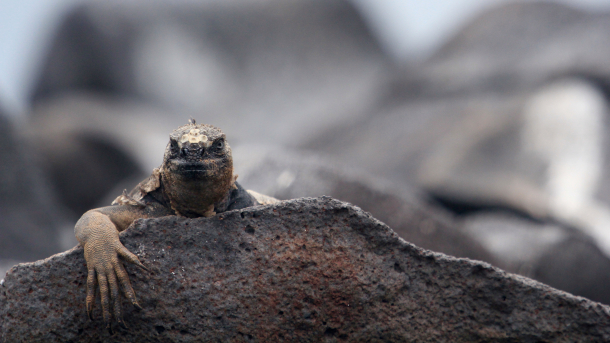
Jennifer Junghans had long dreamed of traveling to the Galapagos to swim with the marine iguanas. (Photo: Jennifer Junghans)
DOERING: So, Aynsley, I know from hearing your stories around the office that you lived in Ecuador for a while and actually you spent some time in the Galapagos, around all those strange and wonderful animals.
O’NEILL: Yes, it was definitely one of the coolest experiences in my life!
BASCOMB: Oh, I’m jealous. The Galapagos is high on my list of places I’d love to visit.
O’NEILL: You definitely should if you ever get the chance. But in the mean time we have a story from writer Jennifer Junghans that will take you to the Galapagos, at least for a few minutes.
JUNGHANS: For as long as I can remember, I’ve dreamed of traveling to the Galapagos Islands to free dive with the ancient marine iguanas and roam the archipelago as Darwin did as he unraveled our story of evolution.
He found little value in the marine iguana, insulting their physical appearance, intelligence and behavior. But I fell in love with them when I saw a photo in National Geographic of this wave of marine iguanas swimming underwater.
[MUSIC: Blue Dot Sessions, “Gullwing Sailor” on Migration, Blue Dot Studios 2017]
I longed to be right there among them, these gentle giants that often look like statues on land armored in scales with faces that resemble a gentler cousin of tyrannosaurus rex, and snaggletoothed spines that jut from head to tail, eyes that stare and large claws at the end of hands that look strangely like our own.
Then, in 2017, I disembarked a small plane from Ecuador and stepped into the remote wilderness of my dreams.
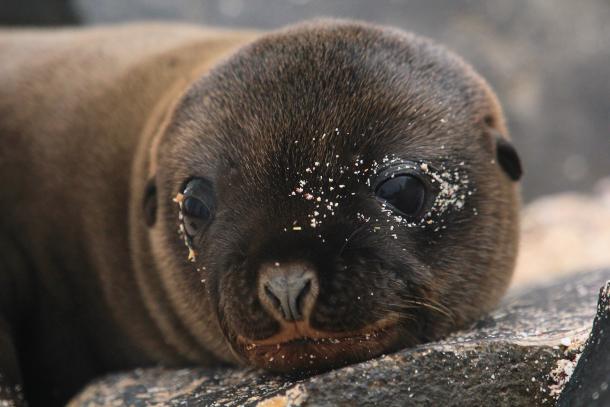
A sea lion pup with sand all over its face (Photo: Jennifer Junghans)
[SFX: ocean waves]
In July, the temperature is cooler, the seas are rougher and the winds are stronger but the lifecycles of the natural world are vigorous and alive.
Here, the animals are abundant and unafraid. In one startling panoramic view, blue-footed boobies dive like torpedoes into turquoise water.
[MUSIC: Blue Dot Sessions, “Gullwing Sailor” on Migration, Blue Dot Studios 2017]
Sea lion pups with giant dark globes for eyes and sand all over their faces follow us as they wait for their mothers to return with food. And colossal numbers of my beloved marine iguanas bask in the sun to warm themselves, piled in tangles of arms and legs and salt-crusted faces.
At night when we anchor at sea, sea lions jump up to rest and sleep on the stern of our boat and we wait for blacktip sharks to appear just below the surface, likely looking to score an easy meal, accustomed to the bycatch fishing boats dump.
I gasp when they appear. Several have come and we peer overboard, the mystery of how big the next one will be or how close it will come or from which direction electrifies my senses. In their presence, Hollywood’s characterization of these beings as man-eating predators crumbles and I feel an undeniable resurrection of a connection once lost.
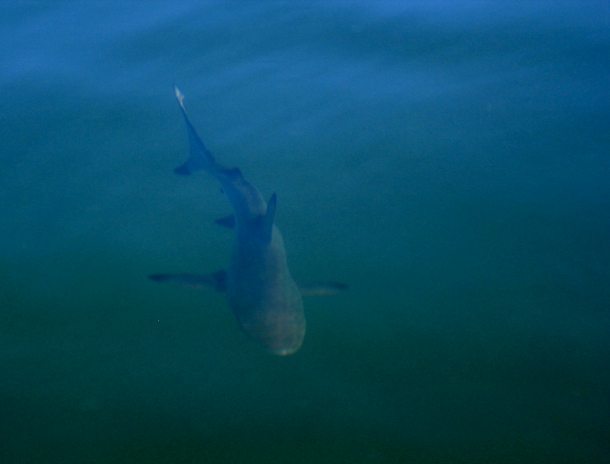
At night, blacktip sharks circled the boat where Jennifer and her fellow travelers slept. (Photo: Jennifer Junghans)
[MUSIC: Blue Dot Sessions, “Gullwing Sailor” on Migration, Blue Dot Studios 2017]
Out here in the wilderness, under the celestial skies in these moments of reverence I am closer to the truth than I’ve ever been. I don’t wonder about the future or question my existence. Somehow, out here, where the planet pulses according to its natural rhythms, it all makes sense.
We take a long hike up rocky terrain to where Blue-footed Boobies have gathered to mate and raise their young.
[SFX: juvenile and adult blue-footed booby calls]
White puffs of down stretch their gaping beaks upward from beneath their mother’s wing and by the magic of serendipity, we witness the flamboyant courtship dance and the rarely seen mating of these birds.
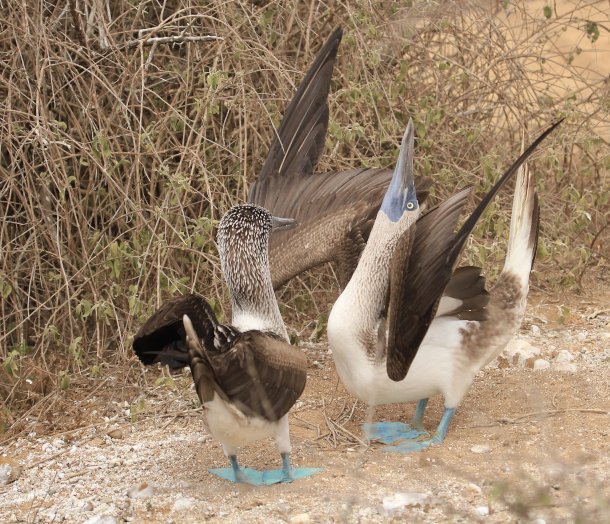
Blue-footed boobies in a courtship dance. (Photo: Jennifer Junghans)
[SFX: underwater breathing sounds]
But it’s a tiny pufferfish that touches me most. Several swim up to me as I snorkel but one stays. She fans her fins, hovering right in front of me, observing me as intently as I observe her. We stay like this, face-to-face, for several minutes.
[MUSIC: Blue Dot Sessions, “Gullwing Sailor” on Migration, Blue Dot Studios 2017]
I’ve never felt so acknowledged or seen. In that moment, the boundary between species blurs. We are two beings who share this planet in a moment of un-interrupted recognition. As different as we look, transcending millions of years of evolution, we come from the same origin — in fact we share strikingly similar genomes with pufferfish — and something inside me innately knows it.
I never did swim with the marine iguanas as I’ve dreamed of. They spent most of their time basking on land even though they depend on the algae clinging to rocks in the sea, but my time here has given me something greater. Wandering among these wild animals at every turn, I attune to how life unfolds and exists when we are the visitor. It’s illuminated what the world once was and the wildness that we are still able to preserve and protect.
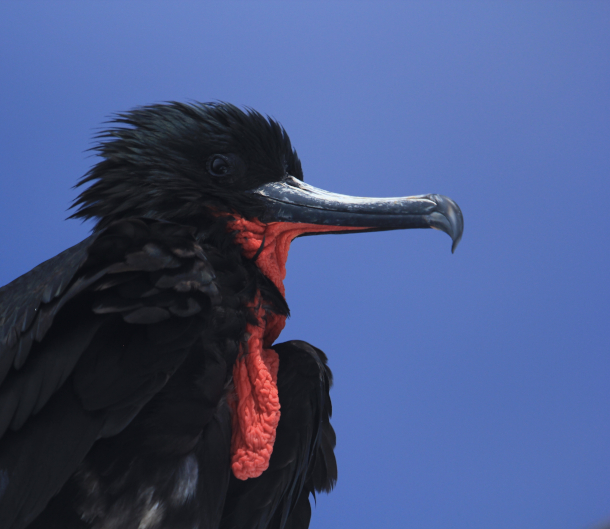
Frigatebirds like this striking male are a familiar sight in the Galapagos. (Photo: Jennifer Junghans)
[MUSIC: Blue Dot Sessions, “Gullwing Sailor” on Migration, Blue Dot Studios 2017]
O'NEILL: Well, first of all, thank you, Jennifer, I loved to hear that. I have to say I was extremely excited to get to speak to you, because coincidentally, I spent some time in the Galapagos Islands, in fact, during July of 2017, so we must have been there overlapping at the same time.
JUNGHANS: Oh, my goodness! I wonder if we crossed paths?
O'NEILL: Well, I was just thinking, I was like, what are the chances? I was very fortunate that I got to spend some time with each of the animals that you wrote here, except for maybe the puffer fish. But I have to say, I love that you have an affection for the marine iguanas, because I do too.
JUNGHANS: Oh!
O'NEILL: Even though they are, like you said, you know, a little bit prehistoric, a little bit salt-crusted, maybe not the most captivating at first sight.
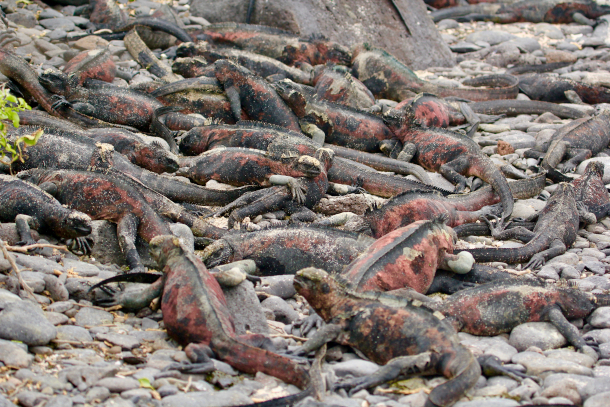
A pile of Jennifer’s beloved marine iguanas. (Photo: Jennifer Junghans)
JUNGHANS: I almost think they are! I tend to gravitate towards the underdog, always. And so when people see these creatures, and they, they think it's ugly, or they don't think it's worthy of the attention, for me, I see beyond all of that immediately. And I, I know that there's a being in their soul just like mine. I, I love them, so much!
O'NEILL: I also loved hearing you talk about the sea lions who would jump up to rest near the stern of the boat. I didn't spend that much time on boats unless I was traveling between islands. But right in front of the school that I was attending was the beach and they would all just come pop up there and hang out with us there.
JUNGHANS: [LAUGHS] Yeah, it's, it's amazing because you, you are always reminded of the rules, to keep your distance from the animals, and stay away, and don't touch them, and don't encourage them. But at the same time, you often find yourself having to move away quickly because they're, they're following after you, or the sea lions are coming up and, and touching their noses to yours as you are snorkeling, or . . . [LAUGHS] I was standing next to this whale skeleton that we had stumbled upon on a beach and my daughter was taking pictures of me and all of a sudden I felt this thing on my back. And it was one of the mockingbirds that had flew onto my bathing suit, crawled up my back, and stood on my head while my daughter was taking photos! And it was wild, because [LAUGHS] you know. . .
O'NEILL: Literally wild! [LAUGHS]
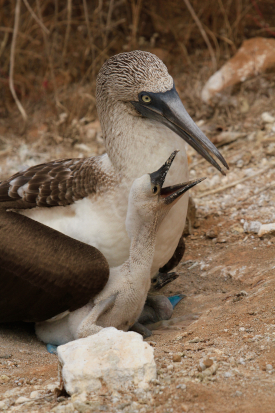
A mother blue-footed booby and her hungry chick. (Photo: Jennifer Junghans)
JUNGHANS: Literally wild. We are used to seeing animals in zoos and aquariums and on television. But, but that's more, you see the shell of an animal. When you are on the Galapagos, you are witnessing this entirety of this being, and it's in its natural place.
[MUSIC: Blue Dot Sessions, “Gullwing Sailor” on Migration, Blue Dot Studios 2017]
O'NEILL: Mmhmm.
JUNGHANS: You can sit and stay among them, and observe this kind of life. And we just, we rarely have the opportunity to do that. So it's, it is wildly magical.
O'NEILL: Writer Jennifer Junghans lives in Sacramento, California. Jennifer, thank you so much for sharing your story with us.
JUNGHANS: Thank you so much, Aynsley. It's been a pleasure to be here.
[MUSIC: Blue Dot Sessions, “Gullwing Sailor” on Migration, Blue Dot Studios 2017]
DOERING: I just love that idea of being truly seen, by of all things, a puffer fish…
BASCOMB: Yeah well I was once truly seen by a barracuda while snorkeling but it wasn't nearly as pleasant!
O’NEILL: Yeesh Bobby what happened?
BASCOMB: Well I was in the Florida Keys and I was snorkeling and I had my head down, like looking down for some reason. And then something made me pick my head up, and right in from of me was the biggest barracuda I’ve ever seen in my life. And they’re almost as big as I am, they have teeth like the size of my index finger. And I don’t mind telling you guys, it scared the pants off me. Although I was in a bathing suit so I guess I wasn’t really wearing pants. [LAUGH] But in any case it was really frightening.
O’NEILL: [LAUGHS] Well, we’re glad you made it out alive, Bobby!
BASCOMB: I did, I did. Thank you.
Related link:
Jennifer Junghans’ website
[MUSIC: Blue Dot Sessions, “Gullwing Sailor” on Migration, Blue Dot Studios 2017]
Native American Stories of Human and Animal Kinship

Dogs hold a special place in many people’s hearts and are lovingly referred to as “man’s best friend”. (Photo: Nathanael Coyne, Flickr, CC BY-NC-ND 2.0)
DOERING: We’re back with Living on Earth, I’m Jenni Doering.
O’NEILL: I’m Aynsley O’Neill
BASCOMB: And I’m Bobby Bascomb.
Many Native American communities belong to a clan which identifies with an animal. There are bear, deer, and loon clans to name a few. Those animals are featured in their traditional stories. So, to hear some of them I called up Joe Bruchac. He is a story teller and musician with the Nulhegan Abenaki tribe of Vermont and Upstate New York. And Joe carves and plays traditional flutes.
[FLUTE MUSIC PERFORMED BY JOE BRUCHAC]
BRUCHAC: We say that the flute came to be when a woodpecker made holes in the hollow branch of a tree that was broken off at the end and the wind blew over it and created that first flute music. So when we play the flute, we try to keep in mind, it's a gift of the trees and the wind, and the birds. A flute could be played for pleasure or to keep yourself from feeling lonely. But also one of the very cool ways that the flute was used is that if a young man fell in love with a young woman, he would compose a song on the flute and play it for her. And if she accepted it, and they became married, she would then write words or compose words for it, and it would become the lullaby sung to their children. Not with a flute, but with a rattle.
BASCOMB: Hmm, it's beautiful. Well, I hope to hear some more of your flute music a little later in this segment. But first, can you get us started with a story? I understand you're gonna tell us a traditional story about dogs.
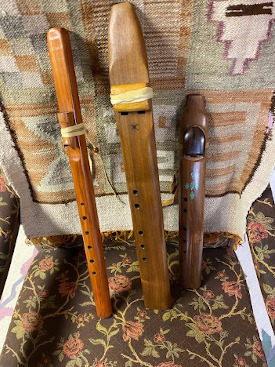
From left to right: A standard 6-hole cedar flute, made by Joe Bruchac. Next, a large double flute, gifted to Joe Bruchac, before finally, a small cedar double flute, made by Eric Marczak. (Photo: Courtesy of Joe Bruchac)
BRUCHAC: That’s right. They say that long ago, the one we call Gluskonba, the first one in the shape of a human being was walking around. This was the time before the people came to be on this land. Now one of the jobs Gluskonba had been given by the Creator was to make things better for those humans when they got here. And so he thought, I wonder what the animals will do when they see a human being for the first time. I better ask them. And so Gluskonba called together a great counsel of all the animal people. And then as he stood before them, he said, I want each of you to come up and when I say the word for human being, tell me what you will do. Now the first one to step forward was the bear. In those days bear was so large, he was taller than the tallest trees. His mouth was so huge, he could swallow an entire wigwam. And when Gluskonba said the word "alnoba", which means human being, the bear said "[bear grunt] I will swallow every human being that I see!" Gluskonba thought about that. He thought to himself, I do not think human beings will enjoy being swallowed by bears, I'd better do something. And so he decided to use one of the powers given to him by the Creator, the power to change things, a power that we human beings also have and often misuse. Gluskonba said to the bear, "you have some burrs caught in your fur, let me comb them out with my fingers". And so the bear sat down in front of him, and Gluskonba began to run his fingers along the bear's back and as he did so, combing out those burrs, he also made the bear gets smaller and smaller, until the bear was the size that bears are to this day. And when Gluskonba said to him, "and now what will you do when you see a human being?" that bear looked at itself and said, "[bear grunt] I will run away!". Which is what bears usually do to this day. Now the next one to come forward was one we call Kitschy moose: the big moose. Moose by the way, is one of our Abenaki words, it means the strange one, and that moose back then was really strange. It was so large that his antlers were bigger than the biggest pines, they were sharper than the sharpest spears, and when Gluskonba said the word "alnoba" that moose said "I will spear every human being I see, spear them on my horns and throw them over the tree tops, and stomp them with my hooves until they're as flat as your hand!" And again Gluskonba thought, "I do not believe human beings will, will feel much pleasure at being speared and flattened by moose, I'd better do something". So he said to that moose, "Nidoba, my friend, you appear to be very strong. Let us have a contest, I will hold up my hands and you will try to push me backward." The moose agreed, it leaned forward, putting its nose in one of Gluskonba's hands, its huge horns in the other, and began to push, and push. But Gluskonba did not move. And that moose's horns got smaller and rounder and the moose itself got very, very, very much smaller than it was before and also his nose got all smushed in. And the moose looked at itself when Gluskonba said, "and now what will you do when you see a human being?", the moose said, "Uhh, I will run away." Now one after another Gluskonba talked to many animals. There's almost for everyone a separate story, but some of them were no danger at all. For example, the rabbit said "when I see a human being I will run around in circles foolishly and be terrified!" which is what rabbit does to this day. Little mice they said "we will sneak into their houses and eat their food!" and Gluskonba said "well, that's not going to hurt them, you can do that". But finally, just one animal was remaining. It sat there in front of him wagging its tail. It was of course the dog, and Gluskonba said to dog, "Nidoba, my friend, are you going to do something to harm the human beings when they arrive here?" And the dog shook its head and said, "No, I've been waiting for human beings to come! I want to be their best best friend, I want to play with their children, I want to go hunting with them, I want to live in their houses with them and share their food and even climb in bed with them, I want to be their best best best best friend!" And Gluskonba looked at that dog, and he saw that dog's heart was good. He said "Nidoba, my friend, you will be the best friend that human beings will ever have, a better friend than some of them deserve; and so we will know you by this name: Aalamos, the one who walks beside us." And so it is that to this day, it is the dog who walks beside us, our best best friend.
BASCOMB: Mhhh, that's a lovely story. You know, I just love dogs, and it always seems that they're better than we deserve in some sense. You know, all they want is some food, a little pat on the head. And they're always there to greet you and always happy with it, wagging tail and what's not to love about a dog?
BRUCHAC: Yeah, the dog is a very special being. And you know, we say that we learn from every animal that each one has something to teach us. For example, the ancestor of the dog is the wolf. We say that human beings learned from the wolf such things as the fact that all of us in our community, like all the wolves in their pack should care for all the children, or that we should be able to sing together and make music just as the wolves do.
BASCOMB: Well, Joe, would you play another song here on your flute? I understand you brought along a double flute with you?
BRUCHAC: Yes, I'd be happy to do so.
[FLUTE MUSIC PERFORMED BY JOE BRUCHAC]
BASCOMB: And Joe, do you have any other stories of animals helping people, that seems to be a theme here?
BRUCHAC: Well, I think one of the good ones to tell is a story about the bears, and a hunter who was not doing the right thing. And this is a version that would be closest to the Seneca version as it was collected by Arthur Parker who was an ethnologist to the early 20th century, and was himself of Seneca origin. The story is that there was a hunter who had to care for his nephew, because the boy's parents had died. That hunter grew tired of caring for his nephew, and said, "Hmm, today, I think I will get rid of this useless boy." So he called his nephew: "my nephew, come with me. I'm going hunting and you could come along". Well that little boy was so happy, his uncle had never taken him hunting before! He was thrilled but as they walked out of the village, he noticed two strange things. The first was they were headed in the direction of the winter land, the North, and it was said that one should not hunt in that direction. The other strange thing was that the hunter did not bring along his dog that was always with him when he hunted. They walked deep, deep towards the north in that forest until they came to a clearing. On the other side of that clearing was a hill and there was a cave opening, a mouth of a cave in the base of that hill. The hunter said, "crawl in there, there are animals, chase them out to me". So he crawled into that cave, deeper and deeper till he came to the end of it and there were no animals there. He turned around, sorry that he was disappointing his uncle. And he saw that circle of light that was the mouth of the cave suddenly disappear. It all was dark. He crawled forward and discovered a big stone had been wedged into the mouth of the cave, trapping him there, and he realized in his uncle had wanted to get rid of him. He felt great sorrow then, not so much for himself, as for his uncle, whose mind was obviously not right, for who in their right mind would do this to an innocent child? Then he began to remember something how his parents had told him if you feel alone and lonely, sing this song, and a friend may come and help you.
So he began to sing "Way-yah-nah way-yah-nah way-yah-nah hey Way-yah-nah way-yah-nah way-yah-nah hey”. And as he as he sang that song, he thought he could hear voices joining in from the other side of that stone. And then suddenly, the stone was rolled away. He crawled out blinking in the light and saw people all around that clearing looking at him, people of all sizes and shapes. He blinked again and realized they were animals all looking at him and an old grandmother woodchuck came up and poked him in the knee and said "grandson, we've heard your song, do you need help?" The boy said, "I do. Indeed, my uncle put me in that cave and I have no parents so I have no family". That old grandmother woodchuck said, "grandson, choose any of us, we'll be your family, you can decide for yourself." Well the boy looked around and seeing all those animals did not know how to choose. So he said, "could you each tell me what your life is like? So I would know if I could do a good job".
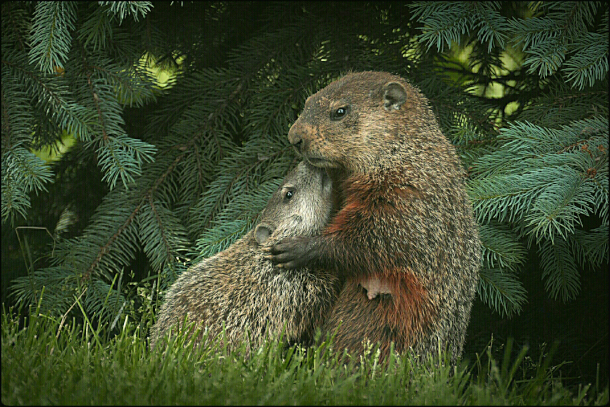
Mother woodchuck holding her baby woodchuck at Greenfield Park in Wisconsin. (Photo: Ken Mattison, Flickr, CC BY-ND-NC 2.0)
So the first one that came up was a little mole. The little mole said, "You would like to be a mole! We burrow in the ground and we eat the most delicious worms." And the little boy thought about that, he really didn't want to eat worms. But he also wanted to be polite. So he said to that little tiny mole, "Oh, my friend I would not be a good mole. Look at my fingers, they're so weak, I can't really dig holes the way you do, I would be terrible at your family's job". Now the next to come forward was the Beaver. The beaver said, "[Munching beaver noise] you would love to be a beaver, we swim underwater and we eat the mhhh best tree bark of all,[Munching beaver noise], wonderful tree bark". Again, the boy thought about eating tree bark, not something very appetizing, but he remembered to be polite. He said, "Beaver, look at my teeth, they're too weak to to cut down trees and I can't swim underwater the way you can, I would be a terrible beaver." And one by one many animals came forward. None of them seemed right until the old mother bear walked toward and said, "my boy, you would love to be a bear, we take our time going through the woods, we eat delicious honey and berries and we sleep in a warm cave together and my two cubs here will wrestle and play with you anytime you want". And the boy said "I'll be a bear!" And indeed, he became a member of their family. He traveled with them everywhere in life, indeed was good at being a bear. And he wrestled and played with his new brothers all the time. But every time they scratched him hair grew on his body, till by the end of the summer, he looked like a bear himself. Now as he went along and the autumn came, each day they heard different hunters, all of them not good enough to catch a bear until the old mother bear said, "Ohh it's two legs and four legs, this one is a good one, we must run!" And they began to run pursued by two legs and four legs behind them they could hear the sound of [Dog Barking] getting closer and closer, until they came to a clearing where an old tree had fallen over a hollow tree.
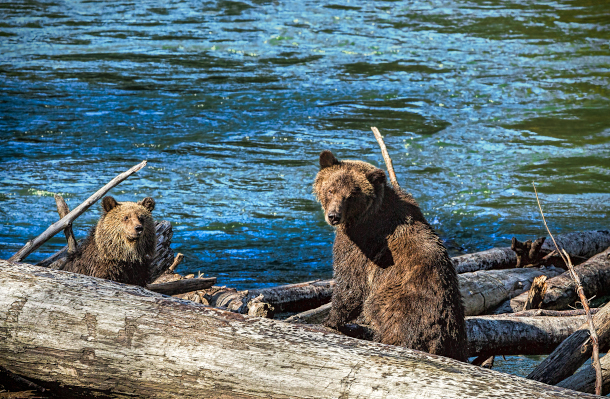
A mother bear giving her cub a fishing lesson at Vancouver Island. (Photo: Sheila Sund, Flickr, CC BY 2.0)
The mother bear said "crawl in here, we may be safe". They crawled into that hollow log and waited. They heard the sound of [Dog Barking] and then silence outside. And suddenly, smoke began to come in to that log. And the boy remembered that that was how hunters would hunt for some animals. If an animal took shelter inside a hollow tree, a fire would be built and smoke would be blown in to make that animal come out. He also remembered he used to be a human being and could speak in human words. And so he called out, "stop, stop!" The smoke stopped coming into the log. He crawled out and there in front of him he saw his uncle, his uncle's dog. His uncle took one step toward him and touched him and all the hair fell off his body and he looked like a human being again. And the uncle said "my nephew, is it you? I thought, I thought you were dead! When I came back to free you from that cave when I realized my mind had been twisted and I done a wrong thing, and I came back and the stone was rolled away and they were animal footprints everywhere. I thought they'd eaten you." And the boy said, "No uncle, they did not eat me, they adopted me; and if you wish me to live again as a human being then you have to accept the bears as your family too." And the uncle agreed. And so it was that, from that time on those who were connected to the bear, the people of the bear clan as well as all of our people remembered the lesson that day: that all of us must keep in our hearts the same love and caring for our children, as you'll find in the heart of a mother bear. And that is how that story goes.
BASCOMB: Hmm it's lovely. Yeah, I mean, you know, you don't mess with a mama bear, right? I love that sentiment.
BRUCHAC: It’s a good story about motherhood because mother bears, whether they're human or not, you don't mess with them.
Joseph Bruchac is an author of more than 120 books for children and a member of the Nulhegan Abenaki Nation. (Photo: Courtesy of Joseph Bruchac)
BASCOMB: Joe Bruchac is a musician, storyteller and member of the Nulhegan Abenaki Nation. Joe thank you so much for telling us all these wonderful stories.
BRUCHAC: Oleohneh, Wlioni which means thank you or good returning to you. And also Wlipamkaani, which means may your journey be good.
[FLUTE MUSIC]
DOERING: Mmm. Well, I feel really inspired by all these stories and I just wanna look for more ways to connect with other species.
O'NEILL: I know, Jenni! What's nice it’s a good little positive feedback loop, the more you become aware of nature the more you become attuned to it. Like when I had this class where I had to take note of every single animal encounter I had. Suddenly I was noticing bird calls everywhere I went.
BASCOMB: Right, you just have to put in a little bit of effort to connect with nature, but once you do, what a rewarding experience it can be.
O'NEILL: I know. This really makes me want to spend more time outside.
DOERING: Mhh yeah, I want to go to the Galapagos now.
BASCOMB: Ooh, take me with you!
DOERING: I know, let’s do a Living on Earth reporting trip to the Galapagos!
BASCOMB: Yeah!
O'NEILL: Good idea. But until then we can look for connections with animals closer to home. like woodchucks, rabbits, and the dogs who walk beside us.
BASCOMB: Right, as we’ve learned in the last hour those connections can bring us just as much joy to our lives.
Related links:
- Learn about writer and storyteller Joseph Bruchac
- Learn more about the Nulhegan Abenaki Nation.
[MUSIC: Tommy Emmanuel, “Rachel’s Lullaby” on The best of Tommysongs, CGP SOUNDS]
DOERING: Living on Earth is produced by the World Media Foundation. Our crew includes Naomi Arenberg, Paloma Beltran, Jay Feinstein, Leah Jablo, Mark Seth Lender, Don Lyman, Isaac Merson, Aaron Mok, Jake Rego, Casey Troost, and Jolanda Omari.
O’NEILL: Tom Tiger engineered our show. Alison Lirish Dean composed our themes. You can hear us anytime at L-O-E dot org, Apple Podcasts and Google Podcasts, and like us, please, on our Facebook page - Living on Earth.
BASCOMB: We tweet from @livingonearth. And find us on Instagram at livingonearthradio. Steve Curwood is our Executive Producer. I’m Bobby Bascomb –
DOERING: I’m Jenni Doering –
O’NEILL: And I’m Aynsley O’Neill.
TOGETHER: Thanks for listening!
ANNOUNCER: Funding for Living on Earth comes from you, our listeners, and from the University of Massachusetts, Boston, in association with its School for the Environment, developing the next generation of environmental leaders. And from the Grantham Foundation for the protection of the environment, supporting strategic communications and collaboration in solving the world’s most pressing environmental problems.
ANNOUNCER 2: PRX.
Living on Earth wants to hear from you!
Living on Earth
62 Calef Highway, Suite 212
Lee, NH 03861
Telephone: 617-287-4121
E-mail: comments@loe.org
Newsletter [Click here]
Donate to Living on Earth!
Living on Earth is an independent media program and relies entirely on contributions from listeners and institutions supporting public service. Please donate now to preserve an independent environmental voice.
NewsletterLiving on Earth offers a weekly delivery of the show's rundown to your mailbox. Sign up for our newsletter today!
 Sailors For The Sea: Be the change you want to sea.
Sailors For The Sea: Be the change you want to sea.
 The Grantham Foundation for the Protection of the Environment: Committed to protecting and improving the health of the global environment.
The Grantham Foundation for the Protection of the Environment: Committed to protecting and improving the health of the global environment.
 Contribute to Living on Earth and receive, as our gift to you, an archival print of one of Mark Seth Lender's extraordinary wildlife photographs. Follow the link to see Mark's current collection of photographs.
Contribute to Living on Earth and receive, as our gift to you, an archival print of one of Mark Seth Lender's extraordinary wildlife photographs. Follow the link to see Mark's current collection of photographs.
 Buy a signed copy of Mark Seth Lender's book Smeagull the Seagull & support Living on Earth
Buy a signed copy of Mark Seth Lender's book Smeagull the Seagull & support Living on Earth

